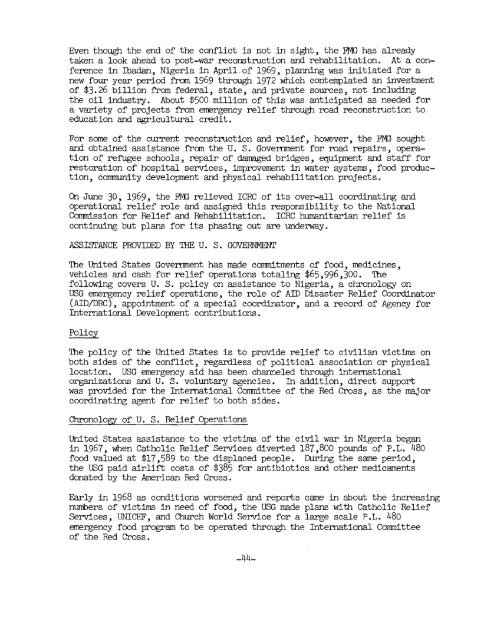3. - usaid
3. - usaid
3. - usaid
Create successful ePaper yourself
Turn your PDF publications into a flip-book with our unique Google optimized e-Paper software.
Even though the end of the conflict is not in sight, the WG has already<br />
taken a look ahead to post-war reconstruction and rehabilitation. At a conference<br />
in Sbadan, Nigeria in April. of 1969, planning was initiated for a<br />
new four year period from 1969 through 1972 which contemplated an investment<br />
of $<strong>3.</strong>26 billion from federal, state, and private sources, not including<br />
the oil industry. About $500 million of this was anticipated as needed for<br />
a variety of projects from emergency relief through road reconstruction to<br />
education and agricultural credit.<br />
For some of the current reconstmction and relief, however, the mvIG sought<br />
and obtained assistance from the U. S. Government for road repairs, operation<br />
of ref'ugee schools, repair of damaged bridges, equipment and staff for<br />
restoration of hospital services, improvement in water systems, food production,<br />
coxmmmity development and physical rehabilitation projects.<br />
On June 30, 1969, the FlvlG relieved ICRC of its over-all coordinating and<br />
operational relief role and assigned this responsibility to the National<br />
Conmission for Relief and Rehabilitation. ICRC hwnanitarian relief is<br />
continuing but plans for its phasing out are underway.<br />
ASSISTANCE PROVIDED BY THE: U.<br />
S. G O V E m<br />
The United States Government has made commitments of food, medicines,<br />
vehicles and cash for relief operations totaling $65,996,300. The<br />
following covers U. S. policy on assistance to Nigeria, a chronology on<br />
USG energency relief operations, the role of AID Disaster Relief Coordinator<br />
(Dm), appointment of a special coordinator, and a record of Agency for<br />
International Development contr:~butions.<br />
Policy<br />
The policy of the United States is to provide relief to civilian victims on<br />
both sides of the conflict, regardless of political association or physical<br />
location. USG emergency aid has been channeled through international<br />
organizations and U. S. voluntary agencies. In addition, direct support<br />
was provided for the International Committee of the.Red Cross, as the major<br />
coordina.ting agent for relief to both sides.<br />
Chronolom of U. S. Relief merations<br />
United States assistance to the victims of the civil war in Nigeria began<br />
in 1967, when Catholic Relief Services diverted 187,800 pounds of P.L. 480<br />
food valued at $17,589 to the displaced people. During the same period,<br />
the USG paid airlift costs of $385 for antibiotics and other medicaments<br />
donated by the American Red Cross.<br />
Early in 1968 as conditions worsened and reports came in about the increasing<br />
numbers of victims in need of food, the USG made plans with Catholic Relief<br />
Services, UNICEF, and Church World Service for a large scale P.L. 480<br />
emergency food program to be operated through the International Committee<br />
of the Red Cross.
















